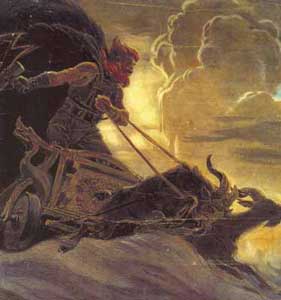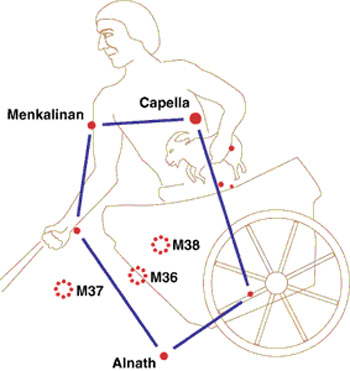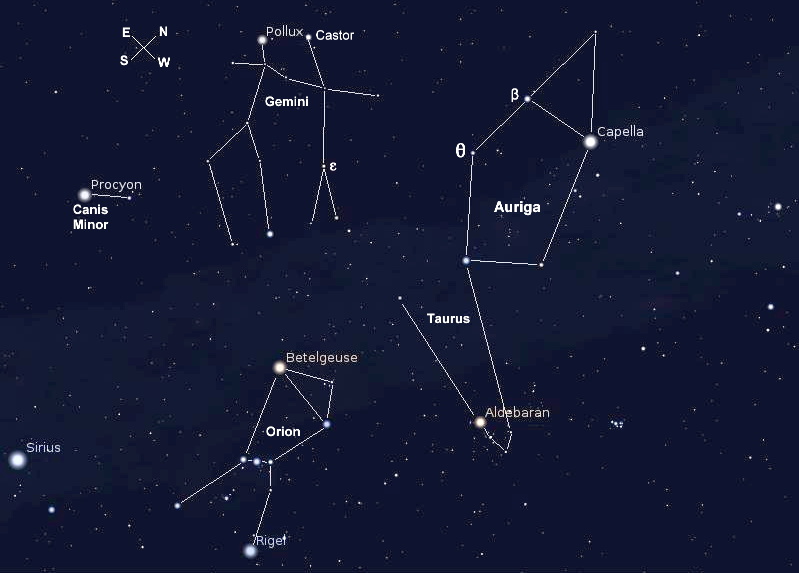Öku-Þórr:
Thor's Chariot and Goat Teamby Peter Krüger
©2012
[Germanic Astronomy]
 |
 |
 |
One of the surprising details we find in Gylfaginning 21 is that Thor [called Öku-Thor, "Cart-Thor" or "Driving-Thor"] owns a chariot pulled by two goats. Wouldn't one assume that the chariot of such a mighty god would be pulled by a pair of splendid stallions instead of goats?
I would like to discuss this in the context of the other details preserved in the description of Thor in Gylfaginning 21:
|
Þórr á hafra tvá, er svá heita:
Tanngnjóstr ok Tanngrisnir, ok reið þá, er hann ekr, en
hafrarnir draga reiðna. Því er hann kallaðr Öku-Þórr. Hann á ok
þrjá kostgripi. Einn þeira er hamarrinn Mjöllnir, er hrímþursar
ok bergrisar kenna, þá er hann kemr á loft, ok er þat eigi
undarligt. Hann hefir lamit margan haus á feðrum eða frændum
þeira. Annan grip á hann beztan, megingjarðar, ok er hann
spennir þeim um sik, þá vex honum ásmegin hálfu. Inn þriðja hlut
á hann, þann er mikill gripr er í. Þat eru járnglófar. Þeira má
hann eigi missa við hamarskaftit.
|
"Thor has two goats, by name Tangnjost and Tangrisner, and a
chariot, wherein he drives. The goats draw the chariot;
wherefore he is called Oku-Thor. He possesses three valuable
treasures. One of them is the hammer Mjolner, which the
frost-giants and mountain-giants well know when it is raised;
and this is not to be wondered at, for with it he has split many
a skull of their fathers or friends. The second treasure he
possesses is Megingjarder (belt of strength); when he girds
himself with it his strength is doubled. His third treasure that
is of so great value is his iron gloves; these he cannot do
without when he lays hold of the hammer's haft." [Rasmus Anderson tr.] |
Using an astronomical approach I
have already associated Thor's hammer Mjölnir
with the asterism of the Pleiades having indeed the shape of a hammer
with a short handle. Since ancient times, the Pleiades have been a marker for the
beginning of winter and summer. Furthermore, I associated
Megingjardar, Thor's Belt of Strength,
with the three stars of the famous belt of Orion, and have shown that the
Jarnglofar, Thor's Iron Gloves,
can also be associated with a third asterism nearby, the head of Cetus,
consisting of five stars and described in Arabian sources as a hand.

Auriga, the Charioteer
If we reach back further to Sumerian cuneiform signs, the name of the
constellation is MUL.GISH.GIGIR, in Akkadian narkabtu: a 'chariot for war,
hunting and ceremony'. But what about the two goats?
 |
If we have a closer look to the stars of Auriga we find there several associations with goats. The star Capella, the third brightest star of the northern celestial hemisphere literally means 'the small nanny goat'. Next to Capella, also in Auriga, we find two more stars called the Haedi, the goat-kids.
Might we be so bold to
assume that a nanny goat and two kids in a constellation called the
chariot may have reference to Thor's goats Tanngnjóstr and Tanngrisnir?
 |
|